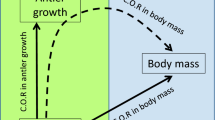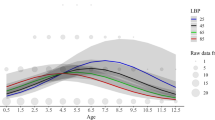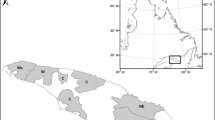Abstract
The manipulation of the sex ratio and age structure in many managed ungulate populations calls for a better understanding of their potential consequences on females’ condition and behavior during rut. During 1996–2002, we manipulated the male age structure and male percentage (nine treatments during 7 years) within an experimental herd of semidomestic reindeer (Rangifer tarandus) and investigated their influence on both the body mass change and the behavior of females during rut. On average, the females lost body mass (−0.95±SE 0.18 kg) during rut, which we contend to reflect somatic costs. The females’ losses increased as the percentage of male decreased, but this was certainly ascribed to one treatment with high male percentage (27.7%) as compared to the others (ranging from 3.9 to 12.2%). Female losses were highest for treatments including both young and adult males as compared to only adult or only young males, and higher for treatments including only young compared to only adult males. This is supported by (1) the higher female harassment frequency when females are exposed to only young or a mixture of young and adult males as compared to only adults, (2) the higher female harassment frequency by young males as compared to adults in the mixed treatments, and (3) the reduced females’ feeding activity in treatments including both young and adult males. We conclude that the male age structure during rut will influence the females’ behavior and mass change and may have implications for females’ life history and for population dynamics.


Similar content being viewed by others
References
Cameron RD, Smith WT, Fancy SG, Gerhart KL, White RG (1993) Calving success of female caribou in relation to body weight. Can J Zool 71:480–486
Carbone C, Taborsky M (1995) Mate choice or harassment avoidance? A question of female control at the lek. Behav Ecol 7:370–378
Carranza J, Valencia K (1999) Red deer females collect on male clumps at mating areas. Behav Ecol 10:525–532
Caughley G (1977) Analyses of vertebrate populations. Wiley, New York
Cederlund G, Markgren G (1987) The development of the Swedish moose population, 1970–83. Swed Wildlife Res (Suppl 1):55–62
Clutton-Brock TH, Guiness FE, Albon SD (1982). Red deer. Behaviour and ecology of two sexes. The University of Chicago Press, Chicago
Clutton-Brock TH, Price OF, MacColl AD (1992) Mate retention, harassment, and the evolution of ungulate leks. Behav Ecol 3:234–242
Espmark Y (1964) Studies in dominance–subordination relationship in a group of semi-domesticated reindeer (Rangifer tarandus L.). Anim Behav 12:420–426
Festa-Bianchet M (1998) Condition-dependent reproductive success in bighorn ewes. Ecol Lett 1:91–94
Grønmyr BE (2004) Factors affecting male reindeer (Rangifer tarandus) activity and behaviour during rut. M.Sc. thesis, Norwegian University of Life Sciences, Ås
Hirotani A (1989) Social relationships of reindeer Rangifer tarandus during rut: implications of females choice. Appl Anim Behav Sci 48:183–202
Holand Ø, Røed KH, Mysterud A, Kumpula J, Nieminen M, Smith ME (2003) The effect of sex ratio and male age structure on reindeer calving. J Wildl Manage 67:25–33
Jennions MD, Petrie M (1997) Variation in mate choice and mating preferences: a review of causes and consequences. Biol Rev 72:283–327
Komers PE, Birgersson B, Ekvall K (1999) Timing of estrus in fallow deer is adjusted to the age of available mates. Am Nat 153:431–436
Kojola I (1985) Influence of age on reproductive effort of male reindeer. J Mammal 72:20–210
Kojola I, Nieminen M (1988) Agression and nearest neighbour distances in female reindeer during the rut. Ethology 77:217–224
Krebs JR, Davies NB (1993) An introduction to behavioural ecology, 3rd edn. Blackwell, Oxford
Kvarnemo C, Ahnesjö I (1996) The dynamics of operational sex ratios and competition for mates. Trends Ecol Evol (Amst) 11:404–408
Langvatn R, Loison A (1999) Consequences of harvesting on age structure, sex ratio and population dynamics of red deer Cervus elphaus in central Norway. Wildlife Biol 5:213–223
Lenvik D, Aune I (1988) Selection strategy in domestic reindeer. Early mortality in calves related to maternal body weight. Nor Landbr Forsk 2:71–76
Martin P, Bateson P (1993) Measuring behaviour: an introductionary guide, 2nd edn. Cambridge University Press, Cambridge
Milner-Gulland EJ, Bukreeva OM, Coulson T, Lushchekina AA, Kholodovas MV, Bekenov AB, Grachev IA (2003) Reproductive collapse in saiga antelope harems. Nature 422:135
Mitchell B, McCowan D, Nicholson IA (1976) Annual cycles weight and condition in Scottish red deer Cervus elaphus. J Zool (1965) 180:107–127
Moore NP (1993) Mating success in fallow (Dama dama, Linnaeus 1758) bucks in Phoenix Park, Ireland. Ph.D. thesis, University College Dublin, Dublin
Mysterud A, Holand Ø, Røed KH, Gjøstein H, Kumpula J, Nieminen M (2003) Effects of age, density and sex ratio on reproductive effort in male reindeer. J Zool (Camb Online) 261:341–344
Noyes JH, Johnson BK, Bryant LD, Findholt SL, Thomas JW (1996) Effect of bull age on conception dates and pregnancy rate of cow elk. J Wildl Manage 60:508–517
Noyes JH, Johnson BK, Dick BL, Kie JG (2002) Effects of male age and female nutritional condition on elk reproduction. J Wildl Manage 66:1301–1307
Reynolds JD (1996) Animal breeding systems. Trends Ecol Evol 11:68–72
Røed KH, Holand Ø, Smith ME, Gjøstein H, Kumpula J, Nieminen M (2002) Reproductive success in reindeer males in herds with varying male composition. Mol Ecol 11:1239–1243
SAS (1999) SAS/STAT guide for personal computers, version 8. SAS Institute Inc., Cary
Schwartz CC (1998) Reproduction, natality and growth. In: Franzmann AW, Schwartz CC (eds) Ecology and management of the North American moose. Smithsonian Institution Press, London, pp 141–171
Shackelton DM (1991) Social maturation and productivity in bighorn sheep: are young males incompetent? Appl Anim Behav Sci 29:173–184
Skogland T (1989) Comparative social organisation of wild reindeer in relation to food, mates and predator avoidance. Adv Ethol (1987) 29:1–74
Smith ME, Holand Ø, Røed KH, Kumpula J, Nieminen M (1999) Harem dynamics of semi-domestic reindeer under different herd compositions of males (abstract). Proceedings of the 10th Arctic Ungulate Conference, Tromsø. Rangifer Rep 4:78
Solberg EJ, Sæther B-E (1994) Male traits as life-history variables: annual variation in body mass and antler size in moose (Alces alces). J Mammal 75:1069–1079
Solberg EJ, Loison A, Ringsby TH, Sæther B-E, Heim M (2002) Biased adult sex ratio affects fecundity in primiparous moose Alces alces. Wildlife Biol 8:117–128
Sæther B-E, Solberg EJ, Heim M (2003) Effects of altering sex ratio structure on the demography of an isolated moose population. J Wildl Manage 67:455–466
Valdez R, Cardenas M, Sanchez J (1991) Disruptive mating behavior by subadult Armenian wild sheep in Iran. Appl Anim Behav Sci 29:165–171
Weladji RB, Mysterud A, Holand Ø, Lenvik D (2002) Age-related reproductive effort in reindeer (Rangifer tarandus): evidence of senescence. Oecologia 131:79–82
Widemo F, Sæther SA (1999) Beauty is in the eye of the beholder: causes and consequences of variation in mating preferences. Trends Ecol Evol 14:26–31
Yoccoz NG, Mysterud A, Langvatn R, Stenseth NC (2002) Age- and density-dependent reproductive effort in male red deer. Proc R Soc Lond B Biol Sci 269:1523–1529
Acknowledgements
We wish to thank the Finnish Reindeer Herders’ Association, Veijo Tervonen, and his crew at Kaamanen Experimental Reindeer Station for valuable assistance and the Finnish Game and Fisheries Research Institute at the Reindeer Research Station in Kaamanen for logistic support. The Norwegian Research Council, the Finnish Game and Fisheries Research Institute, and the Norwegian Reindeer Husbandry Research Council supported the work.
Author information
Authors and Affiliations
Corresponding author
Additional information
Communicated by I. Hartley
Rights and permissions
About this article
Cite this article
Holand, Ø., Weladji, R.B., Røed, K.H. et al. Male age structure influences females’ mass change during rut in a polygynous ungulate: the reindeer (Rangifer tarandus). Behav Ecol Sociobiol 59, 682–688 (2006). https://doi.org/10.1007/s00265-005-0097-5
Received:
Revised:
Accepted:
Published:
Issue Date:
DOI: https://doi.org/10.1007/s00265-005-0097-5




